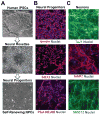Translation: screening for novel therapeutics with disease-relevant cell types derived from human stem cell models
- PMID: 23876186
- PMCID: PMC3815991
- DOI: 10.1016/j.biopsych.2013.05.028
Translation: screening for novel therapeutics with disease-relevant cell types derived from human stem cell models
Abstract
The advent of somatic cell reprogramming technologies-which enables the generation of patient-specific, induced pluripotent stem cell and other trans-differentiated human neuronal cell models-provides new means of gaining insight into the molecular mechanisms and neural substrates of psychiatric disorders. By allowing a more precise understanding of genotype-phenotype relationship in disease-relevant human cell types, the use of reprogramming technologies in tandem with emerging genome engineering approaches provides a previously "missing link" between basic research and translational efforts. In this review, we summarize advances in applying human pluripotent stem cell and reprogramming technologies to generate specific neural subtypes with a focus on the use of these in vitro systems for the discovery of small molecule-probes and novel therapeutics. Examples are given where human cell models of psychiatric disorders have begun to reveal new mechanistic insight into pathophysiology and simultaneously have provided the foundation for developing disease-relevant, phenotypic assays suitable for both functional genomic and chemical screens. A number of areas for future research are discussed, including the need to develop robust methodology for the reproducible, large-scale production of disease-relevant neural cell types in formats compatible with high-throughput screening modalities, including high-content imaging, multidimensional, signature-based screening, and in vitro network with multielectrode arrays. Limitations, including the challenges in recapitulating neurocircuits and non-cell autonomous phenotypes are discussed. Although these technologies are still in active development, we conclude that, as our understanding of how to efficiently generate and probe the plasticity of patient-specific stem models improves, their utility is likely to advance rapidly.
Keywords: Disease-relevant cell type; high-throughput screening; induced pluripotent stem cells; neural progenitors; neuropharmacology; neuroplasticity; phenotypic assays; reprogramming.
Copyright © 2014 Society of Biological Psychiatry. Published by Elsevier Inc. All rights reserved.
Figures



References
-
- Hyman SE. Revolution stalled. Science translational medicine. 2012;4:155cm111. - PubMed
Publication types
MeSH terms
Grants and funding
LinkOut - more resources
Full Text Sources
Other Literature Sources
Medical

